稀土是全球战略性资源。中国是世界稀土资源大国,尤其是离子型稀土储量、产量占世界首位[1-2]。江西省赣州市是中国离子型稀土资源重地。该市寻乌县轻离子型稀土矿世界驰名。自1969年在赣南发现稀土矿并进行开采以来,累计开采稀土约30万t,占全国离子吸附型稀土开采总量的70%以上[3]。离子吸附型稀土矿床裸露于地表,厚度约8~10 m。稀土元素主要以水合离子或羟基水合离子的形式吸附在粘土矿物中。现已经历3代工艺沿替,即第1代池浸工艺、第2代堆浸工艺和第3代原地浸出工艺[4]。矿产开采导致大量稀土及废水、废渣进入矿区周边水土,污染环境,部分稻田被迫停耕[5]。
磷(P)是农作物生长和高产必不可少的元素。Jin等[6-7]通过盆栽水稻,探讨含磷物质对土壤稀土元素生物有效性及细菌群落结构的影响,研究表明不同的含磷材料由于性质不同,其对土壤细菌群落的影响不同。细菌是土壤微生物的主要组成部分。其群落的变化可以揭示土壤生态环境的演变[8]。目前关于施肥如何影响土壤细菌特性的研究结论不尽相同。研究认为施磷肥可增加细菌生物量及多样性[9-12],促进细菌的生产力和产量,增加细菌群落的多样性[13-14],P改变根际细菌(rhizobacteria)群落的丰富度、多样性及群落结构[15-16],但是有的研究认为施磷肥对土壤微生物的组成和结构没有显著影响[17]。赵国强等[18]认为单施磷肥各土层微生物量、碳、氮含量相对于空白均无显著差异。Jin等[19]研究发现,添加含磷材料改变土壤酸碱度(pH)、速效磷(AP)及土壤溶解态的稀土元素浓度。安凤秋[20]发现外源重金属铅和镉的形态与细菌群落结构显著相关。研究表明高浓度稀土镧(La)对土壤细菌产生拟制作用,如显著抑制微生物的呼吸速率,抑制土壤酶活性,影响微生物生理类群和群落结构[21-22]。研究发现,土壤稀土含量与理化性质的变化显著影响土壤细菌多样性和丰度[23-24]。
Jin等[6-7]研究了种植水稻的前提下,P对土壤细菌群落的影响,并且发现了骨炭最具有修复稀土污染土壤的潜力。稀土开采导致矿区周边大量农田被迫停耕,需要修复。郎明[25]的研究表明,P影响根区生态位,根区生态位是影响细菌群落的关键因子。但是到目前为止,关于含磷材料对弃耕农田,尤其是稀土污染稻田的影响十分少见。因此,探讨含磷材料骨炭、过磷酸钙对矿区周边大量荒田、裸地土壤微生物的影响具有一定的理论和现实意义。
1 材料与方法(Materials and methods)
1.1 材料准备
样品采集自寻乌县文峰乡石排村轻稀土矿区停耕3年的土壤,该地经纬度为24°52′53″N,115°42′6″E。蛇形取样,每100 m设一个采样点,共采100个样点,采样深度20 cm。将土样品自然风干,除去草根及枯枝落叶、石块等杂物,过100目筛混合均匀后备用。供试过磷酸钙(SSP)购自上海市沪试生产厂,骨炭(BC)购自山东省滕州化工厂。土壤与含磷材料理化性质及稀土含量如表1所示。将BC、SSP添加至土壤中,共设3个处理:未添加含磷材料(CK)、添加2.5%骨炭(BC)、添加2.5%过磷酸钙(SSP)。每个处理3次重复。供试样品分别装入高20 cm、直径15 cm的硬质PVC桶中。每桶称取4 kg的土壤,共9桶,称取3份0.1 kg的BC、3份0.1 kg的SSP,分别加入对应的土壤样品中,搅拌、混匀,入桶,浸水淹没,保持土壤表面浅水平铺。分别标注CK1、CK2、CK3,BC1、BC2、BC3,SSP1、SSP2、SSP3。样品放置大棚中,大棚内外气温、湿度、光照基本一致。实验起始日为2019年5月1日,40 d和80 d后,即6月10日、7月20日分别采集试验样品,低温保存,送至北京新科开源基因科技有限公司进行高通量测序及数据分析。
1.2 化学分析
土壤基本理化性质的测定参考《土壤农业化学分析方法》。其中,土壤pH值采用水土比2.5∶1电极法;用钼锑抗法和紫外可见分光光度计(型号UV755B,上海元析仪器有限公司,中国)测定土壤中的P含量[26]。土壤样品稀土元素含量采用王水-高氯酸消解法消解。由于ICP-MS用于痕量元素分析,ICP-OES可以检测浓度不超过1%的样品。所以,土壤中含量较高的稀土元素La、Ce和Nd采用ICP-OES测定,含量较低的Pr、Sm、Eu、Gd、Tb、Dy、Ho、Er、Tm、Yb、Lu和Y等稀土元素用ICP-MS测定,采用国家标准样品(土壤GBW07043)进行质量控制[26]。
1.3 16S r RNA基因的扩增和测序
1.3.1 样本准备、文库制备及测序
对6月10日和7月20日的2批样品及时进行DNA样品提取,分别对DNA样本的V3V4区进行PCR扩增,并使用设定的index序列进行样本区分。扩增使用的引物分别为338F (ACTCCTACGGGAGGCAGCA)、806R(GGACTACHVGGGTWTCTAAT)[27]。PCR使用Phusion高保真酶(high-fidelity PCR master with GC buffer),流程为:95 ℃预变性5 min、94 ℃变性30 s、55 ℃退火35 s、72 ℃延伸30 s,以上共30个循环,72 ℃延伸8 min[6-7]。产物使用1.5%琼脂糖凝胶电泳,蓝光观察目的片段。使用凝胶回收试剂盒(Life Technology,USA)进行回收纯化[28],经凝胶电泳检测合格后,对回收纯化的产物,使用Qubit 3.0(Life Technology,USA)进行精确双链DNA浓度定量。将每个样本双链DNA条数设定一致(总量=浓度×体积),均匀混合为1管。使用NEB建库试剂盒进行建库,采用DNA Library Prep Kit for Illumina. NEBNext Ultra(NEB#e7370S/L)中的标准建库流程。对构建出的文库,使用Aglent2100和qPCR分别进行文库长度分布检测和浓度检测。将检测合格的文库使用Illumina Hiseq2500(PE250读长)进行测序[27]。对测序完毕得到的数据进行质控。
1.3.2 下机数据统计
将下机得到的原始数据,使用Ngs Tookit软件进行质控,质量控制采用Bokulich等[29]推荐的参数,质控标准为:删掉质量值Q<15且长度>50%该序列总长度的Reads(即碱基质量差的序列),删掉任意一端含接头序列的Reads(即长度过短的序列),得到分析可用的Clean Data(干净数据),之后根据混样前每个样本的Barcode序列,使用Qiime软件中split_libraries_fastq.py脚本对数据进行拆分(参数设置:Barcode允许最大容错为0 bp,Primer允许最大容错为3 bp),至此得到每个样本的分拆序列。
使用FLASH软件,对各样本正向和反向Fastq文件进行拼接(参数默认最小Overlap=30 bp,Overlap默认错配率为0.3,Phred值默认为33),获得各样本拼接统计Reads数目。
表1 土壤、过磷酸钙(SSP)、骨炭(BC)的理化性质和稀土元素(REE)浓度
Table 1 Physicochemical properties and rare earth element (REE) concentrations of soil
and superphosphate (SSP) and bone charcoal (BC)

类别Items土壤Soil过磷酸钙SSP骨碳BCpH值pH value5.353.169.23化学式Chemical formula-CaP2H4O8Ca3(PO4)2·Ca3CO3P含量P contents0.035%6.1%16%溶解度Solubility难溶于水Poorly soluble 溶于水Soluble in water难溶于水Poorly soluble稀土元素含量/(mg·kg-1)Total REEs/(mg·kg-1)663.6863.198.66
1.3.3 OTU生成及注释
根据序列的相似性,将之归为多个OTU(operational taxonomic unit)。选择相似水平为0.03(即97%序列相似性,大约等同于种水平)进行后续分析。本次分析采用Uclust算法,可以较好地处理长度有一定差异的序列聚类。本次规则定义为:每个OTU总含量≥2,或者>1时给予保留,否则将其OTU舍弃[30]。将精简后的OTU表格供下游所有分析使用。
1.4 统计分析
数据清洗和物种分类,以及后期Alpha多样性分析,使用了软件Mothur v.1.35.0(http://www.mothur.org)。序列注释是微生物多样性分析的一项核心内容。本次分析,针对OTU代表序列进行注释。使用了来自Silva数据库的参考序列(db128版),注释使用Mothur软件的classify.seqs命令,注释算法使用RDP算法(https://www.mothur.org/wiki/Taxonomy_outline)。绘制Heatmap使用Origin9.0,数据可视化采用了Metasee软件和Qiime软件。
2 结果(Results)
2.1 pH及气温
由表2和表3可知,样品培养40 d与80 d期间气温差异较大,BC与SSP不同处理对土壤不同阶段pH产生了不同影响。40 d时,添加SSP的土壤pH有所下降,添加BC的土壤pH显著增大;80 d时,添加SSP和BC,pH均显著升高。
2.2 多样性分析
Alpha多样性指数一般用来衡量单个样本内部的丰富度和多样性高低。计算各个样本的相关统计和分析指数包括覆盖率指数(Good’s Coverage)、丰度指数(OTU数目、Chao和Ace)和多样性指数(Shannon-Weiner指数和Simpson多样性指数)。
图1由F1、F2、F3和F4共4个部分构成,分别表达的是Ace、Chao1、INV-Simpson和Shannon指数。从F1、F2可知,CK、BC和SSP处理40 d土壤细菌群落的Ace、Chao1指数均高于80 d的样品;BC、SSP处理40 d后,前者土壤微生物总数降低,丰富度下降,后者土壤微生物总数、多样性均略有升高。从F3、F4可知,BC处理的土壤细菌群落INV-Simpson、Shannon指数均高于CK和SSP处理的样品;BC、SSP处理40 d后,前者微生物多样性指数INV-Simpson、Shannon均有升高,而后者INV-Simpson下降,Shannon值变化不显著。由图1可知,处理80 d后,BC处理组土壤微生物丰富度、多样性均有升高,SSP处理组丰富度变化不明显,多样性略有下降。
2.3 稀释性曲线
稀释性曲线衡量样本的取样深度。当稀释性曲线趋向与X轴平行时,说明取样的数量充足,更多的取样也可能只产生少量新的OTU;反之则表明继续取样还可能产生较多新的OTU。随机抽样方法,将每个样本每隔50条抽取一次,计算当前OTU数目(式(1)),得到一系列累计值,如图2所示。
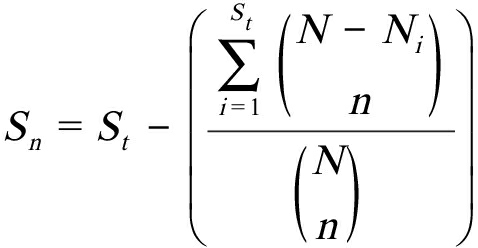
(1)
式中:Sn表示在抽取n个个体后观察到的OTU平均数,St表示N个个体样本中的OTU总数。
表2 不同处理土壤pH值
Table 2 Soil pH value with different treatments

日期 DateCKSSPBC2019.06.10 5.45±0.02b5.03±0.03a6.89±0.01c2019.07.20 5.82±0.05b6.58±0.06a6.73±0.05c
注:字母a、b、c表示不同含磷材料处理之间的显著性差异;“±”表示允许的误差范围。
Note: The letters a, b and c indicate the significant differences among the treatments of different phosphorous materials; “±” indicates the allowable error range.
表3 不同时期的气温
Table 3 Temperature of different periods

时期Period最低气温/℃Lowest temperature/℃最高气温/℃Highest temperature/℃平均气温/℃Average temperature/℃05.01—06.1022.035.030.006.11—07.2027.037.035.0
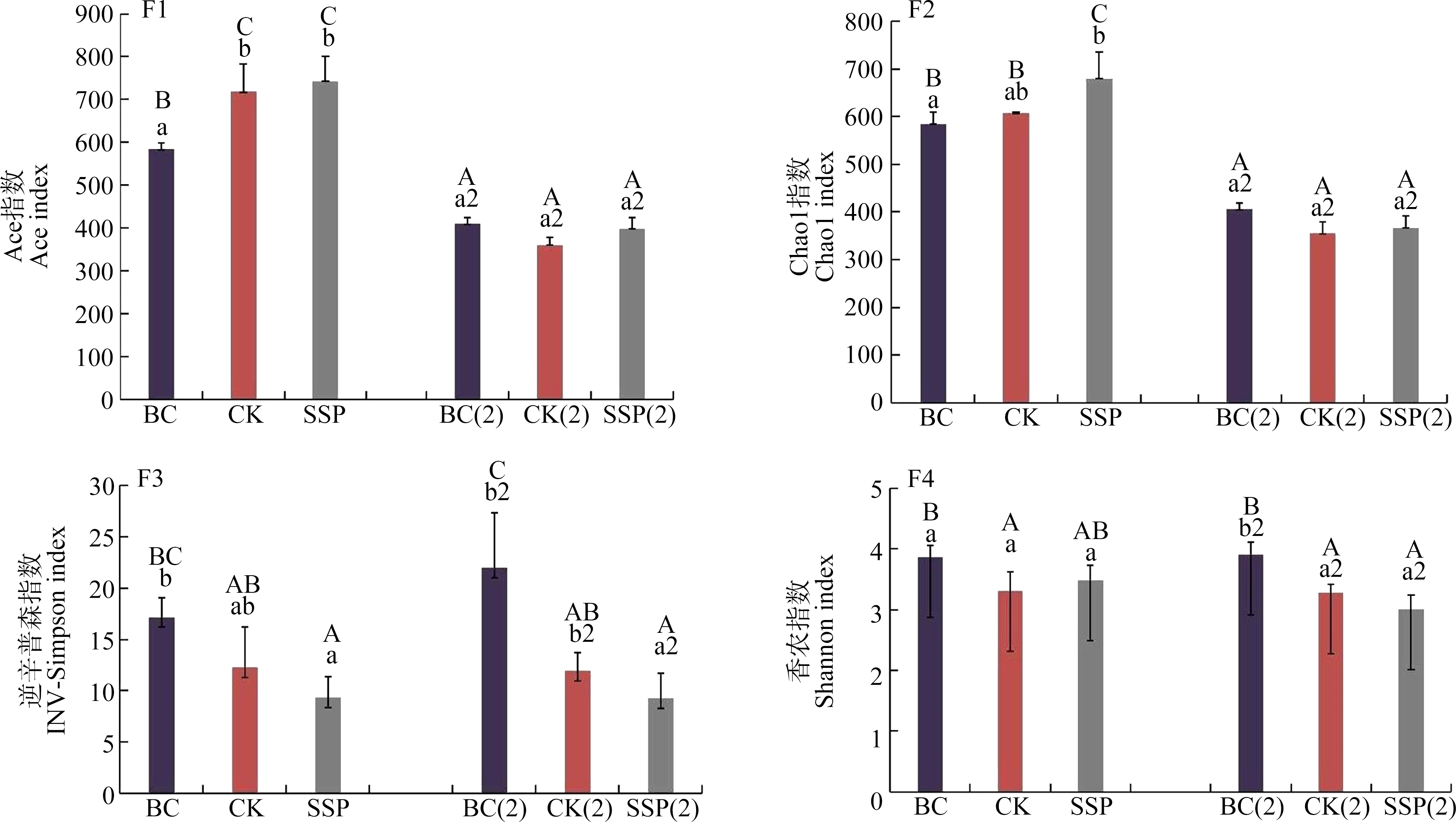
图1 不同含磷材料对土壤群落的α多样性的影响
注:不同的字母表示不同含磷材料处理之间的显著性差异(小写字母表示同一个阶段内的显著性差异,大写字母表示在2个阶段
之间的显著性差异),P<0.05;BC、CK、SSP为培养40 d的样品,BC(2)、CK(2)、SSP(2)为培养80 d的样品,下同。
Fig. 1 The effect of different phosphorous materials on the alpha diversity of soil community
Note: Different letters indicate the significant differences among treatments of different phosphorated materials (Lowercase letters indicate
significant differences in the same stage, and capital letters indicate significant differences in two stages), P<0.05; BC, CK and SSP were
samples cultured for 40 d, BC (2), CK (2) and SSP (2) were samples cultured for 80 d; the same below.

图2 细菌16S基因序列的稀释曲线
Fig. 2 Rarefaction curves of bacterial 16S gene sequences
2.4 对土壤细菌群落影响的差异性分析
由图3可知,第1、2阶段BC、CK、SSP不同处理的各点分布差异较大,同一个阶段内BC、CK、SSP不同处理的各点分布差异也较大,说明非度量多维标度(non-metric multidimensional scaling)NMDS Bray-Curtis差异显著,表明不同阶段BC、CK和SSP不同处理均显著影响了细菌的β多样性。
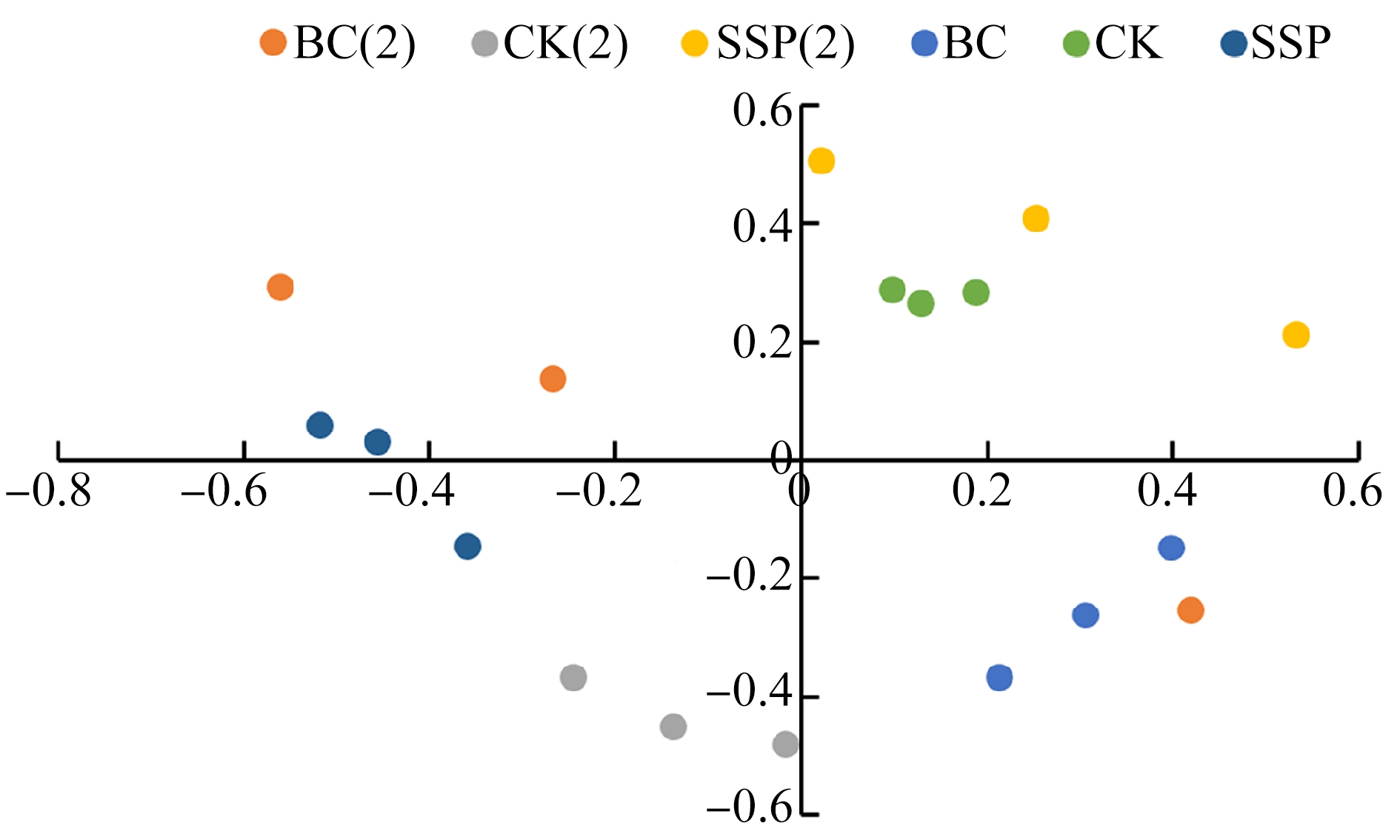
图3 NMDS分析不同磷材料处理土壤细菌群落
结构的相似性
Fig. 3 Similarity of bacterial community structure in soil treated
by different phosphorus materials under the analysis of NMDS
2.5 对土壤细菌群落结构的影响
由图4~图6可知,BC、CK和SSP处理40 d时,门水平有酸杆菌门(Acidobacteria)、Verrucomicrobia、变形菌门(Proteobacteria)>15%,其中SSP处理Acidobacteria平均占65.8%、CK处理平均占52.9%、BC处理平均占25.1%,BC处理Verrucomicrobia平均占45.8%、CK处理平均占30.2%、SSP处理只占7%;纲水平有Acidobacteria、丰佑菌纲(Opitutae)、OPB35_soil_group>15%,其中Acidobacteria门中的Acidobacteria纲,SSP处理平均占65.5%、CK处理平均占52.5%、BC处理平均占23.7%;目水平有酸杆菌目(Acidobacteriales)、丰佑菌目(Opitutales)、OPB35_soil_group>15%,其中Acidobacteria纲中的Acidobacteriales,SSP处理平均占65.5%、CK处理平均占52.5%、BC处理平均占23.7%;科水平有酸杆菌科Acidobacteriaceae_(Subgroup_1)、丰佑菌科(Opitutaceae)、OPB35_soil_group_fa>15%,其中Acidobacteriales目中的Acidobacteriaceae_(Subgroup_1)科,SSP处理平均占65.5%、CK处理平均占52.5%、BC处理平均占23.7%;属水平Candidatus_koribacter、丰佑菌(Opitutus)、OPB35_soil_group_ge>15%,其中Acidobacteriaceae_(Subgroup_1)科中的Candidatus_koribacter属,SSP处理平均占61.1%、CK处理平均占46.6%、BC处理平均占21.8%。
由图4~图6可知,BC、CK和SSP处理80 d时,门水平有Proteobacteria、Verrucomicrobia、Acidobacteria、蓝藻门(Cyanobacteria)、俭菌总门(Parcubacteria)>15%,其中Proteobacteria门在SSP、CK、BC处理时平均占40.0%、23.7%、36.6%;Acidobacteria门在SSP、CK、BC处理时分别平均占3.7%、17.6%、14.3%;Verrucomicrobia门在SSP、CK、BC处理时分别平均占21.9%、8.4%、32.8%;纲水平有Acidobacteria、δ-变形菌纲(Deltaproteobacteria)、γ-变形菌纲(Gammaproteobacteria)、Opitutae、Chloroplast、Verrucomicrobiae、Parcubacteria_cl>15%,其中Acidobacteria纲在SSP、CK、BC处理分别时平均占2.6%、17.4%、13.8%,Deltaproteobacteria纲在SSP、CK、BC处理时分别平均占10.5%、13.4%、24.7%,Gammaproteobacteria纲在SSP、CK、BC处理时平均占27.5%、8.5%、10.1%;目水平有黏球菌目(Myxococcales)、Acidobacteriales、假单胞菌目(Pseudomonadales)、Opitutales、绿弯菌目(Chloroplast)、Verrucomicrobiales、Parcubacteria>15%,Myxococcales目在SSP、CK、BC处理时分别平均占9.7%、13.1%、23.8%,Acidobacteriales目在SSP、CK、BC处理时分别平均占2.6%、17.4%、13.8%,Pseudomonadales目在SSP、CK、BC处理时分别平均占25.2%、5.4%、6.5%;科水平有固氮菌科(Archangiacea)、Acidobacteriaceae_(Subgroup_1)、Opitutaceae、莫拉氏菌科(Moraxellaceae)、Chloroplast_fa、Verrucomicrobiaceae、Pseudomonadaceae>15%,原囊粘菌科(Archangiaceae)在SSP、CK、BC处理时分别平均占7.4%、12.6%、19.7%,Acidobacteriaceae_(Subgroup_1)科在SSP、CK、BC处理时分别平均占2.6%、17.4%、13.8%,Moraxellaceae科在SSP、CK、BC处理时分别平均占24.0%、1.4%、5.2%;属水平厌氧粘细菌(Anaeromyxobacter)、Candidatus_koribacter、丰佑菌(Opitutus)、透明球菌(Perlucidibaca)、Chloroplast_ge、突柄杆菌(Prosthecobacter)、Parcubacteria_ge>15%,Anaeromyxobacter属在SSP、CK、BC处理时分别平均占7.4%、12.6%、20.0%,Candidatus_koribacter属在SSP、CK、BC处理时分别平均占2.2%、15.2%、12.7%,Perlucidibaca属在SSP、CK、BC处理时分别平均占23.9%、1.4%、5.0%。Verrucomicrobia门、Opitutae纲、Opitutales目、Opitutaceae科、Opitutus属在SSP处理时占比均<15%,BC、CK处理时占比均<15%。
3 讨论(Discussion)
稀土矿产开采导致矿区土壤稀土含量过多,影响生态环境。近年来,金姝兰及其团队研究了种植水稻的情况下,含磷材料对土壤生物有效性及细菌群落结构的影响。研究表明,含磷材料影响土壤pH值、土壤溶液稀土元素的浓度,影响土壤主要细菌的门、纲、目、科、属、种的多样性[1,6-7]。本研究在稀土矿区被迫停耕的稻田土壤中添加含磷材料骨炭(BC)和过磷酸钙(SSP)进行实验,在实验进行至40 d和80 d时分别进行了16S r RNA基因的扩增和测序。BC、SSP处理无论是40 d和80 d均对土壤细菌产生显著的不同影响。由于添加不同含磷材料导致土壤pH值不同、不同时段气温的不同以及土壤中可溶解的稀土元素含量的变化,BC处理40 d后,微生物多样性指数INV-Simpson、Shannon均有升高;SSP处理40 d后,土壤微生物总数、多样性均有升高。BC处理80 d后,土壤微生物丰富度、多样性均有升高,SSP处理80 d后,丰富度、多样性变化不大。
大量研究表明,土壤细菌群落结构受pH、P含量、重金属离子浓度、时间和温度等因素的影响[31-37]。土壤中最丰富的微生物是细菌,主要包括变形菌(Proteobacteria)、绿弯菌(Chloroflexi)、拟杆菌(Bacteroidetes)、放线菌(Actinobacteria)和酸杆菌(Acidobacteria)等[38]。pH被认为是影响细菌群落结构和功能的关键因子。本研究表明,BC、CK、SSP处理40 d和80 d,门水平丰度均>10%的包括Acidobacteria和Verrucomicrobia,二者均与pH显著相关,其中Acidobacteria与pH显著负相关,经相关性分析后得出其相关系数为-0.827。研究表明,土壤中添加SSP后由于SSP溶解过程中H+的释放,土壤pH值有所下降[39]。SSP处理40 d时,土壤酸性有所增强,所以40 d时SSP处理Acidobacteria丰度升高,平均占65.8%,Candidatus_koribacter所占比例最高,达61.1%,显著高于其他处理;添加BC土壤酸性下降,pH值升高,BC处理Acidobacteria平均只占25.1%;Verrucomicrobia与pH显著正相关,相关系数为0.705,这与之前的多数研究结果一致[40-41]。本研究发现,CK、BC、SSP处理40 d与80 d时,由于土壤pH变化,土壤细菌的门、纲、目、科、属均发生了变化。有研究表明,变形菌门中的不同菌对pH值要求不同,如Gammaproteobacteria中的Perlucidibaca属适宜pH较低的环境[42],所以SSP处理80 d后,Perlucidibaca占比最高;而Deltaproteobacteria中的Anaeromyxobacter属适宜pH相对高一些的环境,所以BC处理80 d后,Anaeromyxobacter属占比最高。受pH值影响最显著的是OPB35_soil_group_ge,该菌属适宜pH相对高一些的环境,所以无论是40 d,还是80 d时,其丰度均为BC处理>CK处理>SSP处理。

图4 各分类水平>15%的统计结果
注:(a)为培养40 d的样品;(b)为培养80 d的样品。
Fig. 4 The statistical results of each classification level greater than 15%
Note: (a) The sample cultured for 40 d; (b) The sample cultured for 80 d.
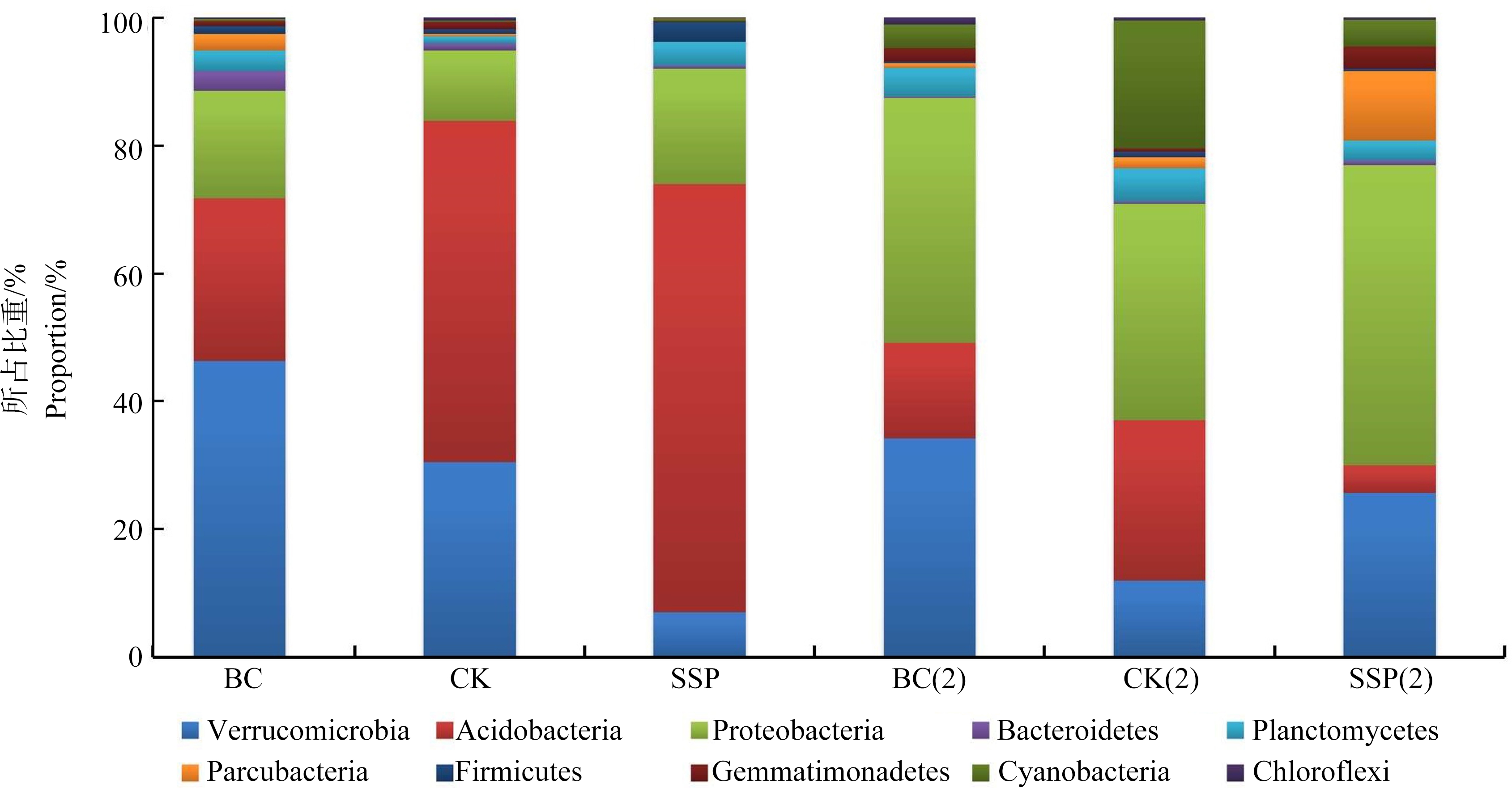
图5 门水平柱状图
Fig. 5 Bar graph of phylum in soil
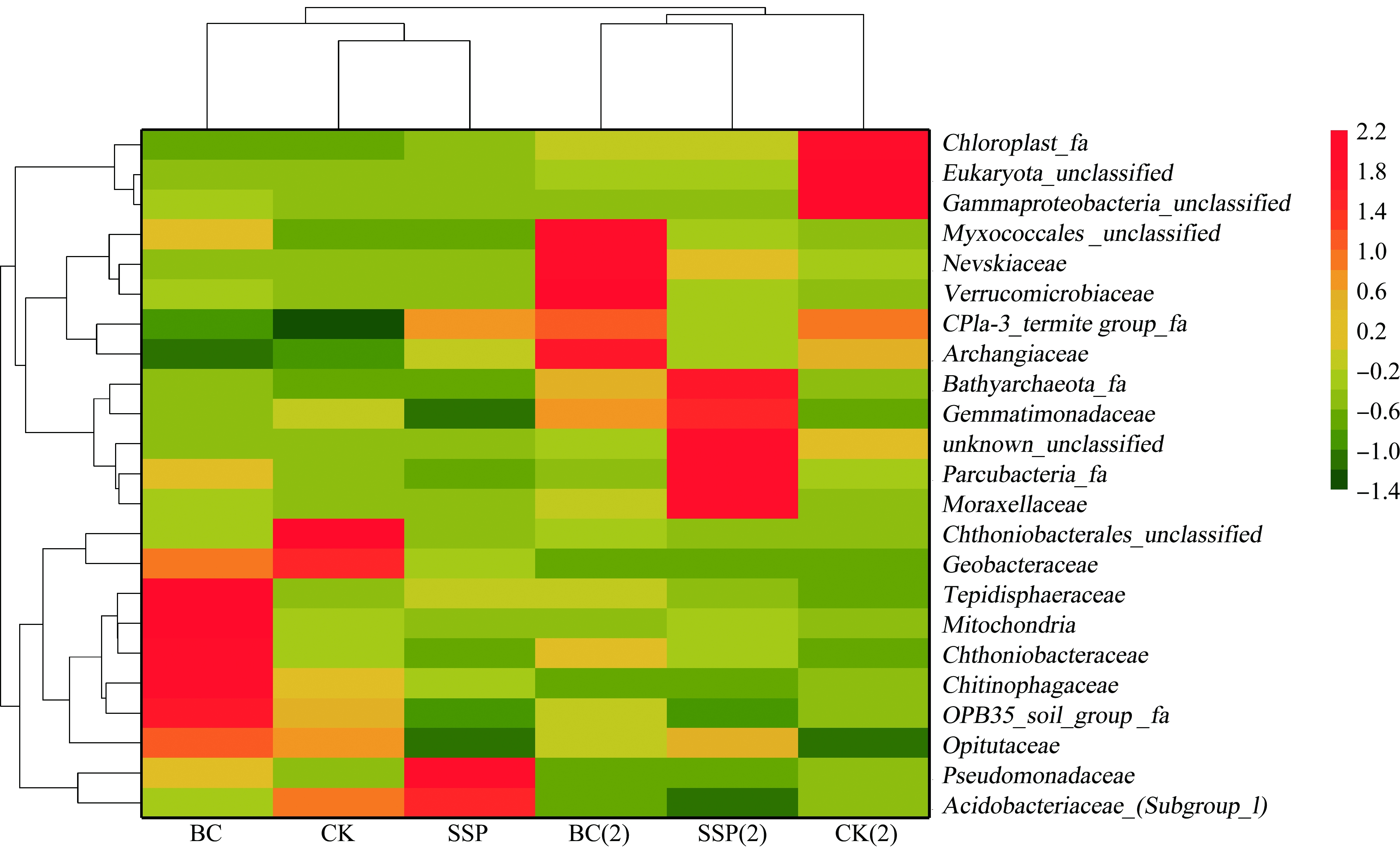
图6 属水平聚类热图
Fig. 6 Heat map of genera in soil
施肥对土壤细菌影响显著,有研究表明增施P肥可促进变形菌门的生长[7],3种处理组在处理40 d和80 d后,门水平丰度>10%有Verrucomicrobia、Proteobacteria,其丰度的变化均与P的添加相关。无论是40 d,还是80 d时,BC处理与SSP处理的土壤Proteobacteria所占比例均大于CK处理;有研究表明[32],与未施肥的对照相比,在施肥处理中Verrucomicrobia的相对丰度均有所增加。本研究中处理40 d和80 d时BC、SSP处理Verrucomicrobia所占比例显著高于CK,这与已有的研究结果一致。
金姝兰等[3]的研究表明,稀土矿区稻田土壤中由于含磷材料的添加,导致土壤溶液稀土元素浓度变化。土壤中Candidatus_koribacter丰度更受土壤溶液中的稀土元素浓度影响,处理80 d后,BC、SSP中的P与土壤中的稀土元素形成磷酸稀土沉淀,减少了溶液中的稀土元素浓度,导致BC、SSP处理的土壤Candidatus_koribacter丰度低于CK处理。土壤细菌群落结构受时间、温度等因素的影响。CK、BC和SSP处理40 d的样品是5月初至6月10日这一时间段培养的,80 d的样品是5月初至7月底这一时间段的。所以80 d的样品温度显著高于40 d的。Ding等[43]和Jin等[1]的研究表明,微生物群落结构受季节和温度的影响。由于40 d的样品与80 d的样品的时间和温度均发生变化,导致细菌群落的丰富度(Chao1、Ace指数)、多样性(INV-Simpson、Shannon指数)均发生了显著变化。
有研究表明,酸性矿山废水污染的河流流域稻田土壤形成了与其他稻田土壤中的Proteobacteria主导的群落结构不同[41]。所以,本次添加BC、SSP对稀土矿区停耕稻田细菌群落影响的研究与之前将含磷材料添加在未停耕稻田土壤的研究结果有所不同。停耕稻田土壤中Proteobacteria的丰度显著低于未停耕土壤,而Acidobacteria、Verrucomicrobia的丰度显著高于未停耕土壤。含磷材料对停耕和未停耕稻田修复效果不一致。Jin等[6]的研究表明,BC是未停耕稻田最有潜力的修复剂,而本研究认为SSP添加40 d后、BC添加80 d后,稀土矿区停耕稻田土壤细菌群落多样性指数均有升高,2种含磷材料均有一定的修复效果。
CK、BC、SSP处理40 d和80 d后,土壤中P含量、pH、稀土离子浓度和温度等不同,对土壤微生物影响不同,BC、SSP对稀土矿区停耕稻田均有一定的修复效果。
(1)pH是影响细菌群落结构和功能的关键因子,Acidobacteria与pH显著负相关,Verrucomicrobia与pH显著正相关;BC、SSP中的P促进变形菌门的生长,无论是40 d,还是80 d时,BC处理与SSP处理的土壤Proteobacteria所占比例均大于CK处理。
(2)BC、SSP中的磷酸根离子与土壤中的稀土元素形成磷酸稀土沉淀,减少了溶液中的稀土元素浓度,导致BC、SSP处理的土壤Candidatus_koribacter丰度低于CK处理;土壤细菌群落结构受时间、温度等因素的影响;CK、BC和SSP处理40~80 d时,随着时间、温度的变化Verrucomicrobia丰度发生了显著变化。
(3)SSP添加40 d后、BC添加80 d后,稀土矿区停耕稻田土壤细菌群落Chao、Ace指数均有升高,土壤细菌群落多样性增大,表明BC、SSP对稀土矿区停耕稻田均有一定的修复效果。
(4)BC、SSP等含磷材料可能促进稀土矿区停耕稻田有益菌的繁殖与富集,修复稀土污染土壤,使停耕稻田的复耕成为可能。
以上结论仅仅是基于实验室的培养实验得出的,实验结果未经大田实验验证,这是本研究的不足,也是下一步我们要开展的工作。
通讯作者简介:金姝兰(1966—),女,硕士,教授,主要研究方向为土壤污染过程与修复机理。
[1] Jin S L, Jin W, Dong C X, et al. Effects of rice straw and rice straw ash on rice growth and α-diversity of bacterial community in rare-earth mining soils [J]. Scientific Reports, 2020, 10(1): 10331
[2] Jin W, Hu Z J, Bai Y J, et al. Response of rice and bacterial communities to the incorporation of rice straw in areas mined for heavy rare earth elements [J]. Bioresources, 2019, 14: 9392-9409
[3] 金姝兰, 黄益宗, 胡莹, 等. 江西典型稀土矿区土壤和农作物中稀土元素含量及其健康风险评价[J]. 环境科学学报, 2014, 34(12): 3084-3093
Jin S L, Huang Y Z, Hu Y, et al. Rare earth elements content and health risk assessment of soil and crops in typical rare earth mine area in Jiangxi Province [J]. Acta Scientiae Circumstantiae, 2014, 34(12): 3084-3093 (in Chinese)
[4] 高志强, 周启星. 稀土矿露天开采过程的污染及对资源和生态环境的影响[J]. 生态学杂志, 2011, 30(12): 2915-2922
Gao Z Q, Zhou Q X. Contamination from rare earth ore strip mining and its impacts on resources and eco-environment [J]. Chinese Journal of Ecology, 2011, 30(12): 2915-2922 (in Chinese)
[5] 金姝兰, 黄益宗. 土壤中稀土元素的生态毒性研究进展[J]. 生态毒理学报, 2014, 9(2): 213-223
Jin S L, Huang Y Z. A review on ecological toxicity of rare earth elements in soil [J]. Asian Journal of Ecotoxicology, 2014, 9(2): 213-223 (in Chinese)
[6] Jin S L, Hu Z J, Man B Y, et al. Application of phosphate-containing materials affects bioavailability of rare earth elements and bacterial community in soils [J]. Science China Technological Sciences, 2019, 62(9): 1616-1627
[7] Jin S L, Jin W, Bai Y J, et al. Response of rice and bacterial community to phosphorus-containing materials in soil-plant ecosystem of rare earth mining area [J]. Journal of Hazardous Materials, 2020, 381: 121004
[8] 厉桂香, 马克明. 土壤微生物多样性海拔格局研究进展[J]. 生态学报, 2018, 38(5): 1521-1529
Li G X, Ma K M. Progress in the study of elevational patterns of soil microbial diversity [J]. Acta Ecologica Sinica, 2018, 38(5): 1521-1529 (in Chinese)
[9] 马垒, 郭志彬, 王道中, 等. 长期三水平磷肥施用梯度对砂姜黑土细菌群落结构和酶活性的影响[J]. 土壤学报, 2019, 56(6): 1459-1470
Ma L, Guo Z B, Wang D Z, et al. Effect of long-term application of phosphorus fertilizer on soil bacterial community structure and enzymatic activity in lime concretion black soil relative to P application rate [J]. Acta Pedologica Sinica, 2019, 56(6): 1459-1470 (in Chinese)
[10] Zhong W H, Cai Z C. Long-term effects of inorganic fertilizers on microbial biomass and community functional diversity in a paddy soil derived from quaternary red clay [J]. Applied Soil Ecology, 2007, 36(2-3): 84-91
[11] Beauregard M S, Hamel C, Atul-Nayyar, et al. Long-term phosphorus fertilization impacts soil fungal and bacterial diversity but not AM fungal community in alfalfa [J]. Microbial Ecology, 2010, 59(2): 379-389
[12] Yi B, Zhang Q C, Gu C, et al. Effects of different fertilization regimes on nitrogen and phosphorus losses by surface runoff and bacterial community in a vegetable soil [J]. Journal of Soils and Sediments, 2018, 18(11): 3186-3196
[13] Teufel A G, Li W, Kiss A J, et al. Impact of nitrogen and phosphorus on phytoplankton production and bacterial community structure in two stratified Antarctic lakes: A bioassay approach [J]. Polar Biology, 2017, 40(5): 1007-1022
[14] Tan H, Barret M, Mooij M J, et al. Long-term phosphorus fertilisation increased the diversity of the total bacterial community and the phoD phosphorus mineraliser group in pasture soils [J]. Biology and Fertility of Soils, 2013, 49(6): 661-672
[15] Lagos L M, Acu a J J, Maruyama F, et al. Effect of phosphorus addition on total and alkaline phosphomonoesterase-harboring bacterial populations in ryegrass rhizosphere microsites [J]. Biology and Fertility of Soils, 2016, 52(7): 1007-1019
a J J, Maruyama F, et al. Effect of phosphorus addition on total and alkaline phosphomonoesterase-harboring bacterial populations in ryegrass rhizosphere microsites [J]. Biology and Fertility of Soils, 2016, 52(7): 1007-1019
[16] Liu M, Liu J, Chen X F, et al. Shifts in bacterial and fungal diversity in a paddy soil faced with phosphorus surplus [J]. Biology and Fertility of Soils, 2018, 54(2): 259-267
[17] Hamel C, Hanson K, Selles F, et al. Seasonal and long-term resource-related variations in soil microbial communities in wheat-based rotations of the Canadian prairie [J]. Soil Biology and Biochemistry, 2006, 38(8): 2104-2116
[18] 赵国强, 王淑平, 崔骁勇, 等. 青藏高原高寒草原土壤微生物量对氮磷肥添加的响应[J]. 中国科学院大学学报, 2018, 35(3): 417-424
Zhao G Q, Wang S P, Cui X Y, et al. Effects of nitrogen and phosphorus application on soil microbial biomass carbon and nitrogen contents on an alpine grassland on Tibetan Plateau [J]. Journal of University of Chinese Academy of Sciences, 2018, 35(3): 417-424 (in Chinese)
[19] Jin S L, Hu Z J, Huang Y Z, et al. Evaluation of several phosphate amendments on rare earth element concentrations in rice plant and soil solution by X-ray diffraction [J]. Chemosphere, 2019, 236: 124322
[20] 安凤秋. 外源重金属铅和镉对土壤生物活性及微生物群落多样性的影响研究[D]. 杨凌: 西北农林科技大学, 2018: 13-16
An F Q. Influence on soil biological activity and bacteria community diversity by exogenous lead and cadmium [D]. Yangling: Northwest A & F University, 2018: 13-16 (in Chinese)
[21] Zhou J Z, Xia B C, Treves D S, et al. Spatial and resource factors influencing high microbial diversity in soil [J]. Applied and Environmental Microbiology, 2002, 68(1): 326-334
[22] 姜照伟, 翁伯琦, 黄元仿, 等. 镧对土壤微生物的影响[J]. 中国稀土学报, 2008, 26(4): 498-502
Jiang Z W, Weng B Q, Huang Y F, et al. Effects of lanthanum on soil microorganism [J]. Journal of the Chinese Rare Earth Society, 2008, 26(4): 498-502 (in Chinese)
[23] 王友生, 侯晓龙, 蔡丽平, 等. 稀土开采对土壤细菌群落组成与多样性的影响[J]. 中国环境科学, 2017, 37(8): 3089-3095
Wang Y S, Hou X L, Cai L P, et al. Impacts of rare earth mining on soil bacterial community composition and biodiversity [J]. China Environmental Science, 2017, 37(8): 3089-3095 (in Chinese)
[24] 王建宏. 包钢尾矿坝外源稀土积累区土壤微生物特征研究[D]. 呼和浩特: 内蒙古师范大学, 2011: 23, 41-42
Wang J H. Study on characteristics of soil microbe in exogenous rare earths accumulation area of Baogang tailings dam [D]. Hohhot: Inner Mongolia Normal University, 2011: 23, 41-42 (in Chinese)
[25] 郎明. 长期施用磷肥土壤微生物的群落结构特征及适应性探究[D]. 北京: 中国农业大学, 2018: 18-19, 21
Lang M. Community structure and adaptation of soil microbiome after long-term phosphorus fertilization [D]. Beijing: China Agricultural University, 2018:18-19, 21 (in Chinese)
[26] 金姝兰, 胡忠俊, 邱秋萍, 等. 含磷材料对土壤溶液稀土元素含量的影响[J]. 生态学杂志, 2018, 37(6): 1693-1701
Jin S L, Hu Z J, Qiu Q P, et al. Effects of phosphorated materials on the concentrations of rare earth elements in soil solution [J]. Chinese Journal of Ecology, 2018, 37(6): 1693-1701 (in Chinese)
[27] 王民煌. 地上/地下碳输入和养分添加对滨海沙地人工林土壤微生物群落结构和功能的影响[D]. 福州: 福建师范大学, 2018: 63
Wang M H. The effect of above/belowground carbon inputs and nutrient inputs on soil microbial community structure and function in a coastal dune forest [D]. Fuzhou: Fujian Normal University, 2018: 63 (in Chinese)
[28] 季卫东. DRD4exonⅢ48bpVNTR等5个功能基因多态性和汉族抽动秽语综合症及其认知功能关系的研究[D]. 成都: 四川大学, 2005: 47-48, 71
Ji W D. A study on the polymorphism of DRD4exonⅢ 48bp VNTR, DAT1, COMTmet/val, IL-1Ra86bp, IL-1βexon5 gene and cognitive function in Han Chinese children with Tourette’s syndrome [D]. Chengdu: Sichuan University, 2005: 47-48, 71 (in Chinese)
[29] Bokulich N A, Subramanian S, Faith J J, et al. Quality-filtering vastly improves diversity estimates from Illumina amplicon sequencing [J]. Nature Methods, 2013, 10(1): 57-59
[30] Kunin V, Engelbrektson A, Ochman H, et al. Wrinkles in the rare biosphere: Pyrosequencing errors can lead to artificial inflation of diversity estimates [J]. Environmental Microbiology, 2010, 12(1): 118-123
[31] Zhou J, Guan D W, Zhou B K, et al. Influence of 34-years of fertilization on bacterial communities in an intensively cultivated black soil in northeast China [J]. Soil Biology and Biochemistry, 2015, 90: 42-51
[32] 杨胜香, 李凤梅, 彭禧柱, 等. 不同碳氮磷源改良剂对铅锌尾矿废弃地土壤微生物群落结构的影响[J]. 农业环境科学学报, 2019, 38(6): 1256-1264
Yang S X, Li F M, Peng X Z, et al. Effects of amendments with different C/N/P ratios on the microbial community structure in Pb-Zn mine tailings [J]. Journal of Agro-Environment Science, 2019, 38(6): 1256-1264 (in Chinese)
[33] 理鹏, 吴建强, 沙晨燕, 等. 粪肥和有机肥施用对稻田土壤微生物群落多样性影响[J]. 环境科学, 2020, 41(9): 4262-4272
Li P, Wu J Q, Sha C Y, et al. Effects of manure and organic fertilizer application on soil microbial community diversity in paddy fields [J]. Environmental Science, 2020, 41(9): 4262-4272 (in Chinese)
[34] Gonzalez-Martinez A, Rodriguez-Sanchez A, Garcia-Ruiz M J, et al. Performance and bacterial community dynamics of a CANON bioreactor acclimated from high to low operational temperatures [J]. Chemical Engineering Journal, 2016, 287: 557-567
[35] Ma Q, Qu Y Y, Shen W L, et al. Bacterial community compositions of coking wastewater treatment plants in steel industry revealed by Illumina high-throughput sequencing [J]. Bioresource Technology, 2015, 179: 436-443
[36] 林海, 崔轩, 董颖博, 等. 铜尾矿库重金属Cu、Zn对细菌群落结构的影响[J]. 中国环境科学, 2014, 34(12): 3182-3188
Lin H, Cui X, Dong Y B, et al. Impact on bacterial community structure of heavy mental of Cu and Zn in copper mine tailings [J]. China Environmental Science, 2014, 34(12): 3182-3188 (in Chinese)
[37] 林耀奔, 叶艳妹, 吴次芳, 等. 水田土壤细菌群落对不同重金属污染水平的响应分析——以A县为例[J]. 环境科学学报, 2020, 40(1): 224-233
Lin Y B, Ye Y M, Wu C F, et al. Response analysis of soil bacterial community to different heavy metal pollution levels in paddy fields: A case study of A County [J]. Acta Scientiae Circumstantiae, 2020, 40(1): 224-233 (in Chinese)
[38] 王光华, 刘俊杰, 于镇华, 等. 土壤酸杆菌门细菌生态学研究进展[J]. 生物技术通报, 2016, 32(2): 14-20
Wang G H, Liu J J, Yu Z H, et al. Research progress of acidobacteria ecology in soils [J]. Biotechnology Bulletin, 2016, 32(2): 14-20 (in Chinese)
[39] Chen D, Wei L, Zou Z C, et al. Bacterial communities in a novel three-dimensional bioelectrochemical denitrification system: The effects of pH [J]. Applied Microbiology and Biotechnology, 2016, 100(15): 6805-6813
[40] 刘彩霞, 董玉红, 焦如珍. 森林土壤中酸杆菌门多样性研究进展[J]. 世界林业研究, 2016, 29(6): 17-22
Liu C X, Dong Y H, Jiao R Z. Research progress in acidobacteria diversity in forest soil [J]. World Forestry Research, 2016, 29(6): 17-22 (in Chinese)
[41] 汪涵. 酸性矿山废水长期灌溉稻田土壤中微生物群落结构时空变化特征及其响应机制[D]. 广州: 华南理工大学, 2018: 27, 33
Wang H. Characteristics of microbial community spatial and temporal change in paddy soil under long-term acid mine drainage irrigation and its response mechanism [D]. Guangzhou: South China University of Technology, 2018: 27, 33 (in Chinese)
[42] Jin S L, Hu Z J, Huang Y Z, et al. Evaluation of several phosphate amendments on rare earth element concentrations in rice plant and soil solution by X-ray diffraction [J]. Chemosphere, 2019, 236: 124322
[43] Ding L J, Su J Q, Sun G X, et al. Increased microbial functional diversity under long-term organic and integrated fertilization in a paddy soil [J]. Applied Microbiology and Biotechnology, 2018, 102(4): 1969-1982